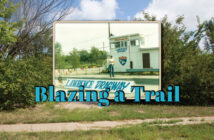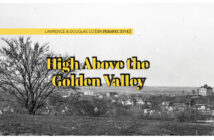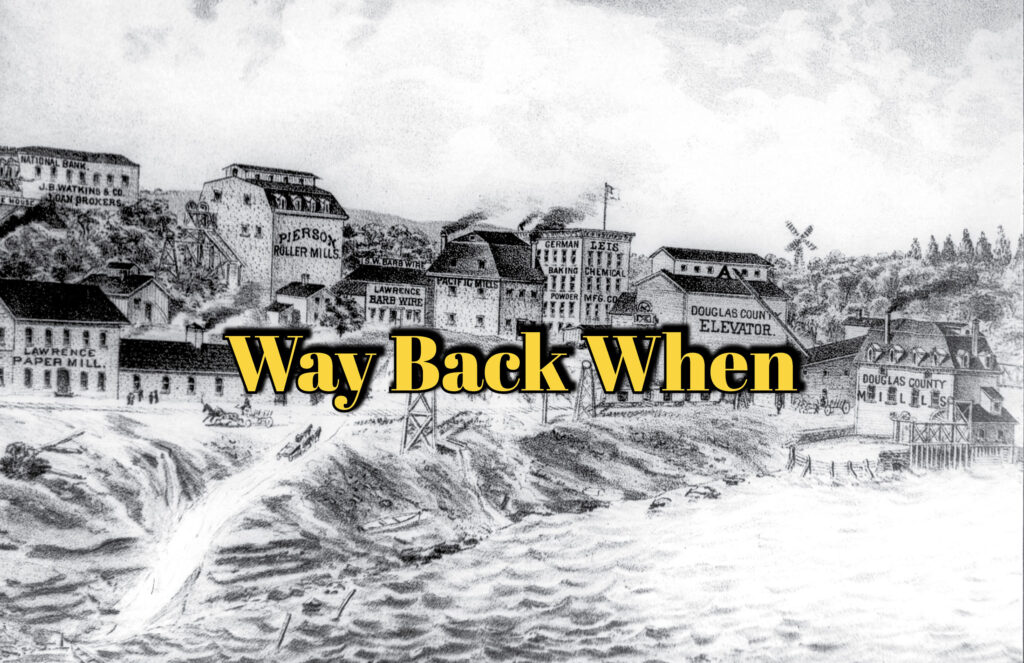| story by | |
| photos by | Steven Hertzog |
& Douglas County Historical Society, Watkins Museum of History
The Turnhalle in East Lawrence was the center of German-American residents’ lives.
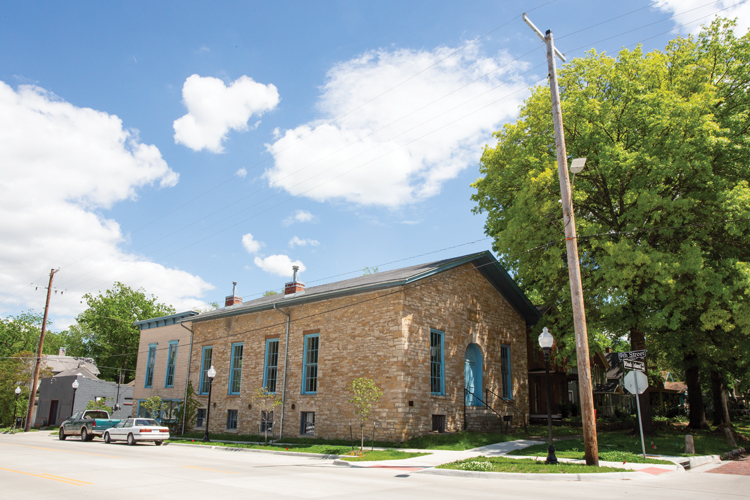
Turnhalle
In the late-19th century, immigrants were critical to the United States’ westward expansion. Between 1870 and 1900, nearly 12 million immigrants arrived here hoping to improve the lives of their families. Many of these immigrants were from Germany, and they were the largest European ethnic group to settle in Kansas. Just over 5,000 German Americans lived in Kansas in the 1860s, but that number had increased to 38,566 by 1889. Many of the Germans who settled in Lawrence built homes east of Massachusetts Street, between Sixth and 18th streets. Two German-speaking churches, St. Paul’s Evangelical Lutheran Church and the German Methodist Episcopal Church, were established. St. Paul’s Church did not have its own building until 1889 and held services in Turner Hall, at the corner of Rhode Island and Ninth streets, from 1870 until that time. The German Methodist Episcopal Church’s building was located on the southeast corner of 10th and New York streets. In addition, Lawrence Germania, a German language newspaper, was published from 1877 to 1918.
As with all ethnic immigrants, German Americans brought with them their language, foods, traditions and other aspects of their culture. One such example is the turnverein, which translates to gymnastics club. In addition to offering gymnastics, the organization served as social club for Germans in Lawrence. The Lawrence turnverein was organized in 1857 to promote good health, fellowship and entertainment. The turnvereins organized in Germany in 1811 had a strong political component, but this was not true in Lawrence. Showing the importance of becoming part of their new country, the Lawrence turnverein required members to apply for U.S. citizenship.
 When the world seems large and complex, we need to remember that great world ideals all begin in some home neighborhood.
When the world seems large and complex, we need to remember that great world ideals all begin in some home neighborhood. 
–Konrad Adenauer
The development of the Lawrence club was impacted by the Civil War. Again, showing loyalty to the U.S., all but four members enlisted in the Union Army. Thus, the club disbanded activities until the end of the war but resumed them then. It acquired a state charter on Jan. 7, 1869, and embarked on a variety of activities. A Kansas Daily Tribune article published on June 3, 1870, announced the newly elected officers for the turnverein and contained the following endorsement of the organization: “The Society is increasing rapidly in numbers, and, as some of our best Germans are members, it is an assurance that the Turnverein is solid and sound.”
The Lawrence Turnhalle, at 900 Rhode Island St., was built in 1869 and restored by the Lawrence Preservation Alliance in 2012. The stone portion of the building was built during the summer of 1869. The first floor of the building housed the gymnastics equipment. Classes were held there, as were gymnastics competitions with turnvereins from neighboring towns. There was a balcony at the west end of the first floor, which was used by spectators watching the competitions. The east end had a stage used for theatrical performances, usually in German. The basement had a long bar and a beer cooler. The turnverein also purchased eight lots on Delaware Street, across from the Hall, for a beer garden.
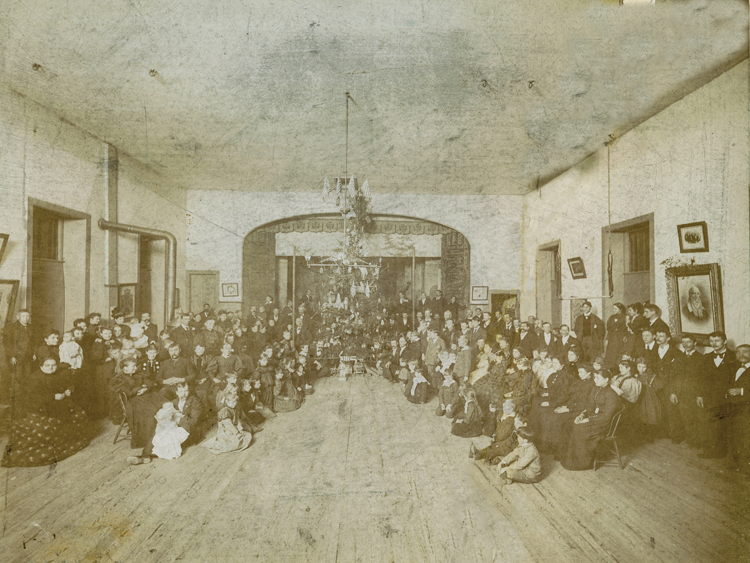
A Christmas celebration in Turnverein Hall.
The basement of the Hall provided a lively social atmosphere for members and their families, as the article “The Story of Turner Hall,” from the KU Max Kade Center for German American Studies Turnverein Collections, illustrates:
- “A long bar extending on the north wall dispensed beer on tap for adults and soda pop for children. You could also buy sandwiches. No hard liquor was served. Walnut card tables had slots under the tops for beersteins, while you sat in captains chairs and played pinochle or skat or other card games. Two bowling alleys were in use most of the time and children were allowed to use them too. The children set up their own pins. A door near the east end of the bar led out to the beer garden in back. In warm weather this was a popular spot. It was lighted at night and there was a fence that enclosed it from the public. Sometimes a group of youngsters would go to the ‘Nickel’ picture show in the 700 block of Massachusetts and after the show would walk down to the Hall to join their parents.”
Membership reached its peak in the 1880s. Dues were $4, and an entrance fee was charged at most events. If a member became ill, these funds were used to provide $3 per week until the patient recovered. The Turnhalle occasionally held benefits to help people in need. In March 1867, a theatrical performance was held to raise money for Mrs. C. Schleifer, whose husband had drowned near Eudora. The money was to be used to help pay her mortgage. The Hall also served as an employment center. On Saturdays, newly arrived German immigrants would gather on the steps to meet employers who were looking for workers. Most of the potential employers were German Americans who owned businesses in Lawrence.
The turnverein’s large variety of social activities had the greatest impact on the community. Announcements noted if the event was going to be in German. When it was not, the advertisement frequently noted that “all are welcome.”
An article in the Lawrence Daily Tribune on Sept. 17, 1872, reported on a Turner picnic held at Haskell’s Grove. The turnverein’s members formed a procession and marched to the picnic grounds as a group, led by the Lawrence German Band. The main activities were dancing, target shooting and gymnastic exercise, which continued throughout the day. The article noted the primary refreshment was Kuntz’s best Leavenworth beer. It also stated: “In the afternoon, quite a number of Americans visited the grove and joined in the dance and other amusements.”
Joint activities were held with turnvereins from nearby communities. In April 1873, about 50 members of the Topeka turnverein and about 25 women traveled to Lawrence by train. They spent the day socializing, and in the evening, the crowded hall enjoyed a theatrical performance by the Topeka Turners.
In January 1876, the Lawrence turnverein celebrated it 10th anniversary. Attendees were entertained with vocal and instrumental music, followed by a farce titled “The Saxon School Master.” Dancing followed the theatrical performance. Admission was 25 cents.
On Nov. 11, 1877, Fritz Schuetz, of Carver, Minnesota, presented the lecture “Dis Bestimmung des Menschen oder: Kein Himmel dort, vieleicht auch keener hier, was bluehtuns puerein Glueck?” While a translation was unavailable, Schuetz was somewhat controversial and described as a free thinker. Obviously aimed at those who spoke German, the doors opened at 7 p.m. with the lecture starting at 8. Admission was 25 cents.
A “Grand Masquerade Ball” was held on Feb. 4, 1879, and the Kansas Daily Tribune advertisement contained the following information:
- “The Lawrence Turnverein will give a Grand Masquerade and Fancy Dress Ball, at their Hall on next Tuesday Evening, February 4. Costumes will be here on Monday, February 3rd, and for inspection at C. Urich’s Boarding House, up stairs, on Mass. street, between Pinckney and Winthrop.”
- Tickets—Each Person with Mask $1. Each person unmasked 50c.
- John Buch’s full Orchestra will furnish the Music, and a general good time will be had.
These few examples of Lawrence turnverein activities show the diversity of the entertainment offered. From theatrical musical performances, gymnastics, shooting competitions and lectures to frequent dancing parties, the Lawrence turnverein brought the community’s German Americans together.


